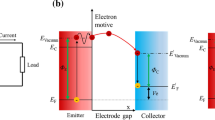Abstract
This article deals with the calculation of the influence of the magnetic field upon the electric current of a thermionic converter presupposing the approach to conditions in a low-pressure cesium converter. The distribution of the starting velocities of the emitted electrons is considered firstly as independent of the angle from the perpendicular to the emitter plane, and secondly according to the cosine law.
The magnetic field effect from the converter current is calculated and compared with the calculations in the papers by Schock [1] and Block [2]; the effect of the external magnetic field is verified by measurements on a solar thermionic converter prototype.
Similar content being viewed by others
Abbreviations
- F=I/I 0 :
-
factor of current reduction from magnetic field effect
- ¯F :
-
value of factorF (when the magnetic field is not constant)
- I [A/m2]:
-
density of collector current (real current influenced by magnetic field)
- I 0 [A/m2]:
-
theoretical density of collector current (in ideal case equals electron emission current)
- T e [°K]:
-
electron gas temperature; assumed equal to emitter temperatureT E [°K]
- B[Wb/m2]:
-
magnetic induction (field)
- D[m]:
-
distance from emitter to collector
- R[m]:
-
radius of electrodes, emitter and collector
- r[m]:
-
variable radius in the limits 0 toR
- V [m/s]:
-
random velocity of electron
- v xz [m/s]:
-
component of the vectorV inx-z plane
- v m =√2kT E /m:
-
most probable velocity in the velocity distribution according to Maxwell and Boltzmann
- w-v xz /v m :
-
relatively expressed electron velocityv xz
- γ :
-
the angle of any vectorV
- ϱ [m]:
-
radius of circular electron path
- n [m−3]:
-
number (density) of electrons with certain value of random velocity
- n 0 [m−3]:
-
total electron number (density)
- n 1 [m−3]:
-
number of electrons returned to emitter by means of magnetic field
- N 0 [m−2s−1]:
-
total flow of thermionic electrons emitted from a unit surface
- N 1 [m−2s−1]:
-
partial flow of electrons returned to emitter
- P=N 1/N0 :
-
relatively expressed flow of electrons returned to emitter (whenB = const.)
- ¯P :
-
mean value ofP (whenB ≠ const.)
- F cos,\(\overline {F_{COS} } \),P cos,\(\overline {P_{COS} } \) :
-
values asF,¯F,P,¯P in case of velocity distribution according to cosine law
- m=9·107×10−31 [gk]:
-
electron mass
- e=1·60×10−19 [C]:
-
electron charge
- k×1·38×10−23 [J/grad]:
-
Boltzmann's constant
- μ 0 :
-
1·257×10−6 [H/Vs] permeability of vacuum
References
Schock A.: J. Appl. Phys. 31 (1960), 1978.
Block F. G., Corregan F. H., Eastman G. Y., Fendley J. R., Hernquist F. G., Hills. E. J.: Proc. IRE (1960), 1846.
Kramář J.: Res. Rep. SVÚSE — Z 1060, Běchovice, October (1963).
Author information
Authors and Affiliations
Rights and permissions
About this article
Cite this article
Kramář, J. Influence of magnetic field on cesium thermionic energy converter. Czech J Phys 15, 190–200 (1965). https://doi.org/10.1007/BF01688864
Issue Date:
DOI: https://doi.org/10.1007/BF01688864




